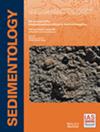Holocene seismic activity in south‐eastern Switzerland: Evidence from the sedimentary record of Lake Silvaplana
IF 2.8
2区 地球科学
Q1 GEOLOGY
引用次数: 1
Abstract
High‐Alpine regions are prone to a large variety of geohazards, among which earthquakes have the strongest impact on landscape and local population. Historic records indicate a moderate to high seismic activity in the northern, south‐western and central parts of Switzerland. In contrast, south‐eastern Switzerland has less historic earthquake chronicles due to the low population density, resulting in a poorly constrained seismic event catalogue. The aim of this study is to evaluate the palaeoseismic activity for south‐eastern Switzerland by using the sedimentary record of Lake Silvaplana in the Engadine Valley. A dense grid of high‐resolution two‐dimensional seismic profiles, high‐resolution bathymetry and a 10 m long sediment core from the deepest basin were used to investigate the stratigraphy of the lake sediments. The bathymetry reveals a flat basin, flanked by steep slopes to the north‐west and south‐east. The acoustic basement consists of four ridges, and gently‐dipping fans to the south‐west and north‐east. Expressions of slope failure can be identified in all domains of the lake floor and the subsurface data. Multiple coevally‐triggered chaotic mass‐flow deposits, overlain by megaturbidites with a coarse‐sand base, have been detected along ten horizons in the seismic data. The four most recent of these deposits are cored and radiocarbon dated to approximately 230, 310, 960 and 1330 cal yr BP, indicating four over‐regional seismic events that triggered large slope failures in Lake Silvaplana in the last 1400 years. Correlation with sediments of Lake Sils, Lake Como, Lake Iseo and Lake Ledro indicate within radiocarbon uncertainties a large earthquake around 1330 cal yr BP. Within their age ranges, the postulated earthquake at 310 cal yr BP (1640 CE) further correlates with a moment magnitude Mw ca 5.4 event in Ftan in 1622 CE, and the 960 cal yr BP (990 CE) earthquake correlates with a Mw ca 5.2 earthquake in Brescia in 1065 CE. Six mass‐movement deposits, also suggested to be caused by earthquakes, were not reached by the sediment core and have suggested ages between 7800 and 11300 cal yr BP. Thus, Lake Silvaplana sediments provide the first reliable record of seismic activity for the mid and Late Holocene in this region, likely related to the neotectonic activity of the Engadine Line, a major fault zone running along the main valley.瑞士东南部全新世地震活动:来自Silvaplana湖沉积记录的证据
高高山地区容易发生各种地质灾害,其中地震对景观和当地人口的影响最大。历史记录表明,瑞士北部、西南部和中部地区的地震活动中度到高度。相比之下,由于人口密度低,瑞士东南部的历史地震编年史较少,导致地震事件目录约束较差。本研究的目的是利用恩加丁山谷Silvaplana湖的沉积记录来评价瑞士东南部的古地震活动。利用高分辨率二维地震剖面的密集网格、高分辨率测深和来自最深盆地的10米长的沉积物岩心来研究湖泊沉积物的地层学。水深测量显示了一个平坦的盆地,两侧是西北和东南的陡峭斜坡。声学基底由四个山脊组成,西南和东北有缓慢倾斜的扇。斜坡破坏的表达式可以在湖底和地下数据的所有域中识别出来。在地震资料中,在10个层位上发现了多个共凹触发的混沌质量流沉积,其上覆盖着粗砂基的超缓积岩。这些沉积物中最近的四个已被取心,放射性碳测年约为230、310、960和1330 calyr BP,表明在过去1400年里,四次跨区域地震事件引发了西尔瓦普拉纳湖的大规模斜坡破坏。与锡尔斯湖、科莫湖、伊塞奥湖和莱德罗湖沉积物的对比表明,在放射性碳不确定度范围内,约1330 calyr BP发生了一次大地震。在他们的年龄范围内,310 cal yr BP(公元1640年)的假定地震与1622年发生在Ftan的矩震级为Mw - 5.4级的地震进一步相关,960 cal yr BP(公元990年)的地震与1065年发生在布雷西亚的Mw - 5.2级地震相关。6个质量运动沉积物,也被认为是由地震引起的,没有被沉积物岩心到达,并且年龄在7800到11300 cal yr BP之间。因此,西尔瓦普兰湖沉积物为该地区全新世中晚期的地震活动提供了第一个可靠的记录,可能与恩加丁线的新构造活动有关,恩加丁线是沿主山谷运行的主要断裂带。
本文章由计算机程序翻译,如有差异,请以英文原文为准。
求助全文
约1分钟内获得全文
求助全文
来源期刊

Sedimentology
地学-地质学
CiteScore
8.20
自引率
11.40%
发文量
94
审稿时长
6-12 weeks
期刊介绍:
The international leader in its field, Sedimentology publishes ground-breaking research from across the spectrum of sedimentology, sedimentary geology and sedimentary geochemistry.
Areas covered include: experimental and theoretical grain transport; sediment fluxes; modern and ancient sedimentary environments; sequence stratigraphy sediment-organism interaction; palaeosoils; diagenesis; stable isotope geochemistry; environmental sedimentology
 求助内容:
求助内容: 应助结果提醒方式:
应助结果提醒方式:


